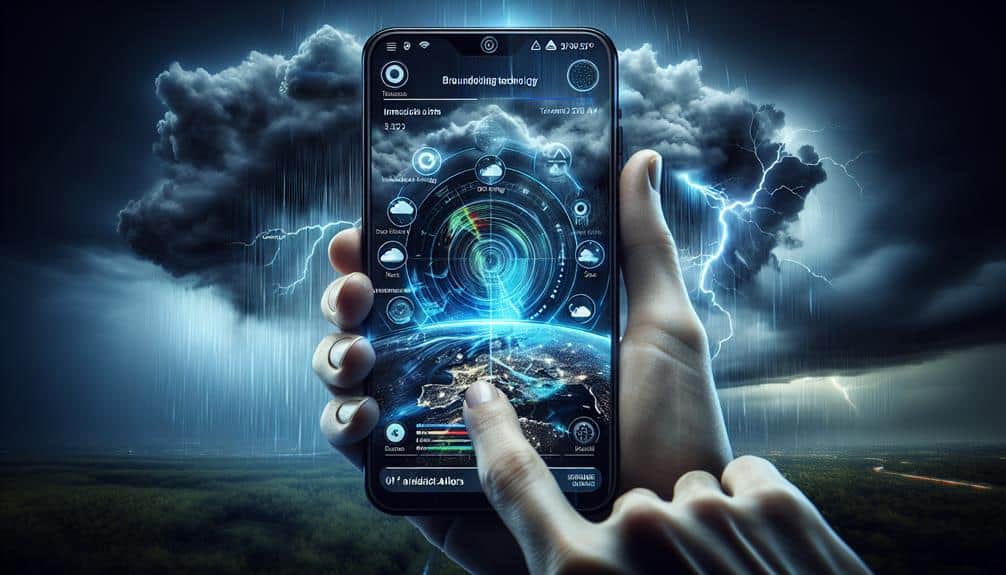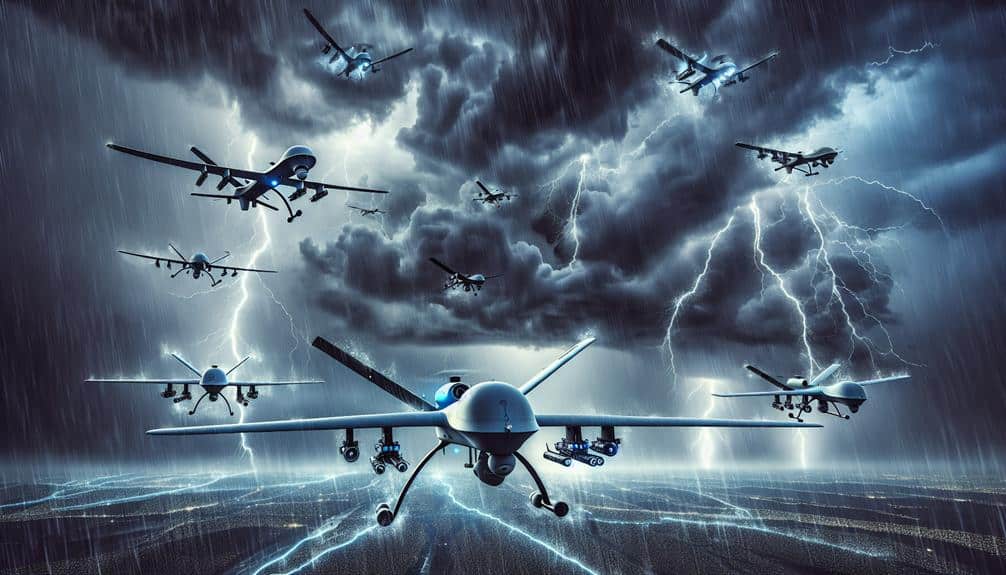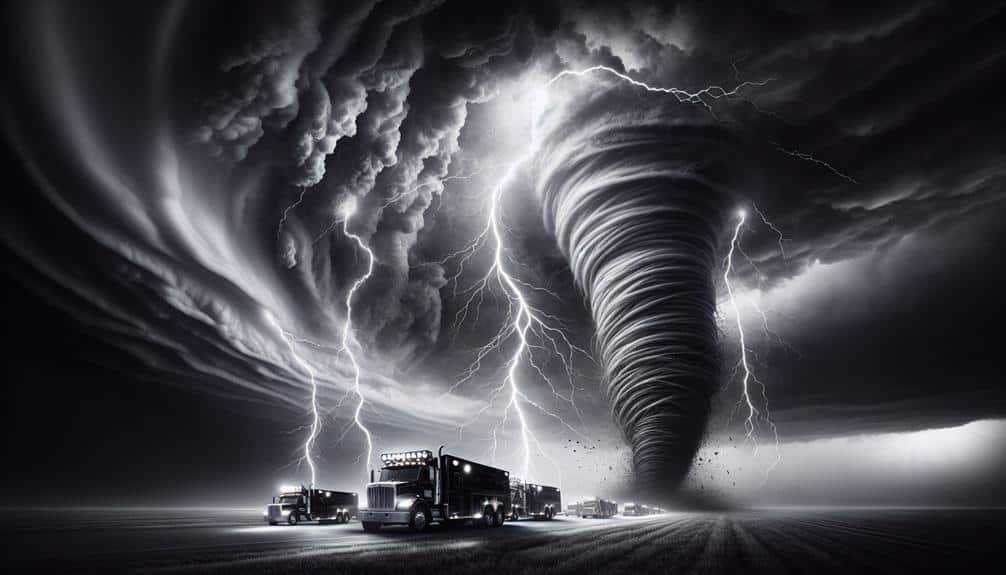We're witnessing a revolution in real-time storm monitoring technology driven by advanced radar systems like Doppler and phased array radars, which provide precise tracking and high-resolution data. Satellite imaging enhancements offer detailed, high-resolution views analyzed by machine learning algorithms. IoT weather sensors collect accurate meteorological data, while AI and machine learning techniques enhance forecasting reliability. Mobile weather apps deliver real-time storm data, turning smartphones into powerful tracking tools. Crowdsourced data enriches storm analysis with hyper-local insights and UAVs capture detailed atmospheric readings. With these innovations, our ability to predict and respond to storms is transforming. Stay tuned for a deeper understanding.
Key Points
- Advanced radar systems with Doppler and phased array technologies enhance real-time storm tracking and provide rapid updates for timely warnings.
- Satellite imaging advances, including high-resolution and machine learning integration, offer detailed weather pattern analysis and timely alerts.
- IoT weather sensors gather high-resolution data, validated and refined by machine learning models, improving storm prediction accuracy.
- AI and machine learning algorithms enhance forecasting reliability, offering detailed insights on storm trajectory, intensity, and impact zones.
Advanced Radar Systems
How do advanced radar systems improve our ability to monitor storms in real-time?
By employing precision tracking and high-resolution data, these systems significantly enhance weather forecasting and storm detection. Unlike conventional radars, advanced radar systems like Doppler and phased array radars offer detailed, real-time monitoring of atmospheric conditions. This is achieved through rapid scanning techniques and dual-polarization technology, which allow us to dissect storm structures and identify precipitation types with unparalleled accuracy.
The real-time monitoring capabilities of advanced radar systems empower us to predict severe weather events with greater lead time and precision.
For example, Doppler radar measures the velocity of precipitation particles, providing crucial insights into storm rotation and potential tornado formation. Phased array radars, on the other hand, offer rapid updates, scanning the entire atmosphere in seconds rather than minutes. This ensures we're receiving the most current data, essential for issuing timely warnings and making informed decisions.
Additionally, these radar systems enhance storm detection by reducing clutter and improving signal clarity. By filtering out non-meteorological objects, we achieve a clearer picture of storm dynamics, enabling us to track storms' paths with exceptional accuracy.
Advanced radar technology thus plays a vital role in safeguarding our freedom to live and travel safely.
Satellite Imaging Advances
Building on the precision of advanced radar systems, satellite imaging advances offer a detailed, high-altitude perspective that enhances our real-time storm monitoring capabilities. High resolution imagery from modern satellites provides exceptional detail, allowing us to observe and analyze weather patterns with remarkable accuracy. By capturing images at various spectral bands, we can detect moisture levels, cloud formations, and temperature variations, improving our predictive models.
We now have the ability to track the development and trajectory of storms with unparalleled clarity. The integration of data from geostationary and polar-orbiting satellites offers an all-encompassing view, enabling us to identify potential threats earlier and with greater confidence. This high-resolution imagery supports detailed weather pattern analysis, essential for understanding storm dynamics and enhancing forecast accuracy.
Moreover, advancements in machine learning algorithms allow us to process vast amounts of satellite data more effectively. Automated systems can now identify key indicators of severe weather, such as wind shear and vorticity, providing timely alerts. This capability not only empowers meteorologists but also offers us, the general public, more flexibility to prepare and respond effectively to impending storms.
IoT Weather Sensors
Let's analyze the impact of IoT weather sensors on storm monitoring.
These devices offer enhanced data accuracy by continuously collecting localized meteorological data, leading to more precise storm predictions.
Additionally, their rapid deployment capabilities enable swift response in dynamic weather conditions, notably improving our real-time monitoring efficiency.
Enhanced Data Accuracy
IoT weather sensors significantly enhance data accuracy by providing real-time, high-resolution meteorological measurements. These sensors seamlessly integrate with advanced algorithms for data validation, ensuring that the information we collect is both accurate and reliable. By continuously cross-referencing data points from multiple sources, we achieve significant error reduction.
The precision of IoT weather sensors allows us to capture minute atmospheric changes, leading to more precise storm predictions and timely warnings. For instance, sensors can detect subtle variations in temperature, humidity, and wind speed, which are essential for understanding storm dynamics. This high-resolution data is then processed using machine learning models that further refine accuracy by learning from historical patterns and real-time inputs.
In our pursuit of data integrity, we employ rigorous calibration procedures and frequent maintenance checks. By doing so, we mitigate the risks associated with sensor drift and environmental interference. Additionally, the decentralized nature of IoT networks means that data loss from a single node doesn't compromise the overall dataset. This redundancy is vital for maintaining continuous, reliable data streams, ensuring that our storm monitoring systems remain robust and trustworthy.
Enhanced data accuracy ultimately empowers us with the knowledge to make informed, timely decisions.
Rapid Deployment Capabilities
The rapid deployment capabilities of our weather sensors enable swift establishment of monitoring networks in response to emerging storm threats. By leveraging IoT technology, we can deploy sensors in key regions within hours, facilitating immediate data collection. This agility is essential for emergency response and disaster management teams who need real-time information to make informed decisions.
Our sensors feature plug-and-play functionality, securing quick setup without the need for specialized technical expertise. With mesh networking, each sensor communicates seamlessly with others, creating a robust data network resilient to individual sensor failures. The data streams provide detailed insights into weather patterns, enhancing predictive models and allowing for proactive measures.
Moreover, these sensors are equipped with advanced power management systems, utilizing solar panels and low-power operation modes to guarantee uninterrupted data collection even in remote locations. This reliability is critical during severe weather events when traditional infrastructure may be compromised.
We've also integrated edge computing capabilities, enabling real-time data processing directly at the sensor level. This reduces latency and ensures that critical information reaches disaster management teams without delay. By enhancing our rapid deployment capabilities, we empower communities to better prepare for and respond to storm threats, safeguarding lives and property.
AI and Machine Learning
Let's harness AI and machine learning to enhance predictive analytics accuracy, integrating vast datasets from various sources.
By employing advanced data integration techniques, we can improve our real-time analysis capabilities.
Additionally, automated response systems enable us to react swiftly and effectively to storm developments, minimizing potential damage.
Predictive Analytics Accuracy
Utilizing AI and machine learning, we can achieve unparalleled predictive analytics accuracy in real-time storm monitoring technology. These technological advancements enhance forecasting reliability, enabling us to make more informed decisions and take timely actions.
By leveraging sophisticated data analysis techniques, we can refine our prediction precision, making storm forecasts more dependable than ever before. Machine learning algorithms process vast datasets, identifying patterns and anomalies that human analysts might miss. This capability guarantees our predictive models continuously improve, adapting to new data and evolving weather patterns.
AI-driven analytics offer detailed insights, such as storm trajectory, intensity, and potential impact zones, allowing for more comprehensive and accurate forecasts. Moreover, the integration of ensemble methods in AI allows us to combine multiple predictive models, increasing overall forecasting reliability. These methods mitigate the uncertainties inherent in weather predictions by considering various possible outcomes and their probabilities.
Data Integration Techniques
To improve predictive analytics accuracy, we must focus on advanced data integration techniques within AI and machine learning frameworks. This approach allows us to merge diverse data streams, such as satellite imagery, weather sensors, and historical storm patterns, into a cohesive dataset. By doing so, we can leverage advanced algorithms to produce more reliable storm forecasts and critical insights.
Data integration in real-time storm monitoring involves several key steps:
- Data Aggregation: Collecting data from multiple sources gathers a diverse dataset. The more varied and extensive the data, the more accurate our predictive models become.
- Data Visualization: Transforming raw data into visual formats like heat maps and predictive graphs enables us to intuitively grasp complex patterns and trends, thereby facilitating quicker decision-making.
- Data Security: Maintaining robust data encryption and secure transmission protocols is paramount to protect sensitive information and maintain trust in our monitoring systems.
Automated Response Systems
Harnessing the power of AI and machine learning, we can automate response systems to swiftly and accurately react to real-time storm data. By leveraging advanced algorithms, we're capable of processing vast amounts of meteorological information, enabling us to issue emergency alerts with unprecedented speed and precision. This ensures that at-risk populations receive timely warnings, enhancing their ability to make informed decisions and maintain their freedom during severe weather events.
Our systems don't just stop at sending alerts. They're also pivotal in response coordination. By integrating machine learning models, we can predict storm paths and intensities, allowing us to allocate resources more efficiently. For instance, our AI-driven platforms can automatically dispatch emergency services and optimize evacuation routes, minimizing chaos and maximizing safety.
Moreover, these automated systems continuously learn and adapt. As more storm data is processed, machine learning algorithms refine their predictions, leading to more accurate and reliable responses over time. This dynamic capability reduces human error and increases operational efficiency, freeing up emergency personnel to focus on critical tasks.
Essentially, by embedding AI and machine learning into our storm response strategies, we're creating a more resilient and autonomous disaster management framework.
Mobile Weather Apps

Mobile weather apps leverage advanced meteorological algorithms and high-resolution satellite imagery to provide real-time storm data, offering unparalleled precision and immediacy. These apps transform our smartphones into powerful tools for storm tracking, maximizing user engagement through intuitive interfaces and extensive customization options tailored to our specific needs.
Battery life optimization is crucial for these apps to ensure our devices remain functional during critical weather events. By employing efficient coding practices and minimizing background processes, these apps deliver essential information without draining our batteries. Push notifications keep us informed in real time, offering timely alerts that can be the difference between safety and peril.
Consider the emotional impact of these features:
- Peace of Mind: Instant access to accurate storm data can ease anxiety during severe weather conditions.
- Empowerment: Customization options give us control over the information we receive, empowering us to make informed decisions.
- Reliability: Battery life optimization ensures our devices remain reliable when we need them most.
Crowdsourced Data
Expanding beyond the capabilities of mobile weather apps, crowdsourced data offers a dynamic and granular perspective on storm conditions by aggregating observations from millions of users worldwide. This community engagement empowers individuals to contribute real-time information, enhancing our understanding of rapidly evolving weather patterns. Through platforms like Weather Underground and social media channels, users share observations such as precipitation, wind speed, and localized flooding, creating a rich tapestry of data points.
We rely on sophisticated algorithms to verify data reliability, filtering out outliers and ensuring that the information we gather is accurate. Machine learning models cross-reference user reports with official meteorological data, flagging inconsistencies and validating credible inputs. This dual-layer verification process increases the precision of storm monitoring, providing a robust dataset that can be used for predictive analytics.
Not only does crowdsourced data democratize weather reporting, but it also allows for hyper-local insights that traditional methods might overlook. By embracing this decentralized approach, we gain a more nuanced view of storm impacts, aiding in timely responses and better preparedness.
As we continue to innovate, the role of community engagement in storm monitoring will unquestionably become even more pivotal in enhancing data reliability and operational efficiency.
Drones and UAVs

Drones and UAVs revolutionize storm monitoring by providing high-resolution, real-time data that enhances predictive models and situational awareness. We're witnessing a paradigm shift where these technological marvels deliver unprecedented insights into storm dynamics. By deploying drone surveillance, we can capture detailed atmospheric readings that were previously impossible with traditional methods.
UAV technology advancements have led to the creation of highly durable and autonomous drones capable of withstanding extreme weather conditions. These drones offer several benefits:
- Enhanced Predictive Models: Real-time data collection improves the accuracy of storm trajectory and intensity forecasts, enabling better preparation and response strategies.
- Increased Safety: By utilizing drones, we can reduce the need for human intervention in dangerous environments, minimizing risk and ensuring safety.
- Rapid Deployment: Drones can be quickly deployed to storm-affected areas, providing immediate situational awareness and facilitating timely decision-making.
With these innovations, we're not just improving our ability to monitor storms; we're empowering ourselves with the freedom to act proactively. The integration of drone surveillance into our storm monitoring systems represents a significant leap forward, offering enhanced precision and reliability.
Therefore, UAV technology advancements continue to redefine the boundaries of meteorological science.
Frequently Asked Questions
How Does Storm Monitoring Technology Impact Insurance Risk Assessments?
We see storm monitoring technology's impact on premiums as significant; it informs risk mitigation strategies by providing precise data. This empowers us to make data-driven decisions, ensuring fair assessments and allowing policyholders more freedom in managing risks.
What Are the Environmental Impacts of Deploying New Storm Monitoring Technologies?
We're evaluating the environmental impacts of deploying new storm monitoring technologies. While these systems enhance data accuracy, we must make sure they align with environmental conservation principles to minimize ecological disruption and maximize sustainable monitoring practices.
How Accurate Are Long-Term Storm Predictions With Current Technology?
With a crystal ball's clarity, our storm tracking accuracy has improved. Current weather forecasting technology achieves about 70-80% accuracy for long-term predictions, giving us the freedom to make informed decisions and better prepare for future storms.
What Is the Cost of Implementing Advanced Storm Monitoring Systems in Developing Countries?
We must conduct a detailed cost analysis to understand the financial burden. Implementation challenges in developing countries include infrastructure gaps and training needs, which can greatly raise costs, potentially exceeding millions, limiting their ability to adopt advanced storm monitoring systems.
How Is Personal Privacy Protected With the Use of Storm Monitoring Technology?
Imagine Big Brother watching every raindrop. We guarantee privacy protection through robust data encryption. Our storm monitoring tech respects your freedom, securing personal information and preventing unauthorized access while precisely analyzing storm data.
